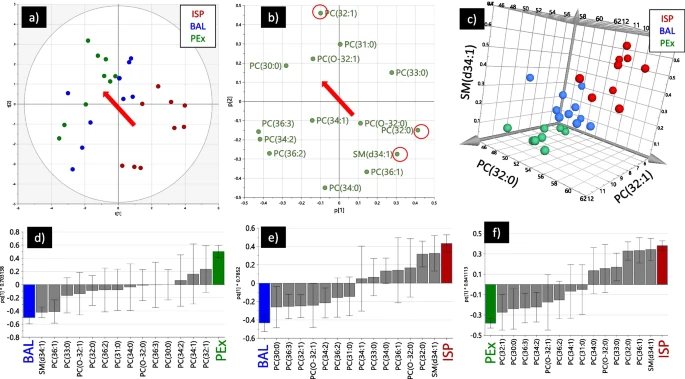Research – Open access

Per Larsson, Olaf Holz, Grielof Koster, Anthony Postle, Anna-Carin Olin & Jens M. Hohlfeld
BMC Pulmonary Medicine volume 23, Article number: 423 (2023)
Abstract
Background
Surfactant phospholipid (PL) composition plays an important role in lung diseases. We compared the PL composition of non-invasively collected exhaled breath particles (PEx) with bronchoalveolar lavage (BAL) and induced sputum (ISP) at baseline and following endotoxin (LPS) challenges.
Methods
PEx and BAL were collected from ten healthy nonsmoking participants before and after segmental LPS challenge. Four weeks later, PEx and ISP were sampled in the week before and after a whole lung LPS inhalation challenge. PL composition was analysed using mass spectrometry.
Results

The overall PL composition of BAL, ISP and PEx was similar, with PC(32:0) and PC(34:1) representing the largest fractions in all three sample types (baseline PC(32:0) geometric mean mol%: 52.1, 56.9, and 51.7, PC(34:1) mol%: 11.7, 11.9 and 11.4, respectively). Despite this similarity, PEx PL composition was more closely related to BAL than to ISP. For most lipids comparable inter-individual differences in BAL, ISP, and PEx were found. PL composition of PEx was repeatable. The most pronounced increase following segmental LPS challenge was detected for SM(d34:1) in BAL (0.24 to 0.52 mol%) and following inhalation LPS challenge in ISP (0.45 to 0.68 mol%). An increase of SM(d34:1) following segmental LPS challenge was also detectable in PEx (0.099 to 0.103 mol%). The inhalation challenge did not change PL composition of PEx.
Conclusion
Our data supports the peripheral origin of PEx. The lack of PL changes in PEx after inhalation challenge might to be due to the overall weaker response of inhaled LPS which primarily affects the larger airways. Compared with BAL, which always contains lining fluid from both peripheral lung and central airways, PEx analysis might add value as a selective and non-invasive method to investigate peripheral airway PL composition.
